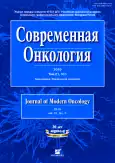Предсказательная ценность цифровой маммографии, ультразвукового исследования и их комбинации в диагностике раннего рака молочной железы
- Авторы: Алиева Г.С.1, Корженкова Г.П.1, Колядина И.В.1,2
-
Учреждения:
- ФГБУ «НМИЦ онкологии им. Н.Н. Блохина»
- ФГБОУ ДПО РМАНПО
- Выпуск: Том 21, № 3 (2019)
- Страницы: 38-45
- Раздел: Статьи
- URL: https://journals.rcsi.science/1815-1434/article/view/33523
- DOI: https://doi.org/10.26442/18151434.2019.3.190550
- ID: 33523
Цитировать
Полный текст
Аннотация
Полный текст
Открыть статью на сайте журналаОб авторах
Гюнель Сабировна Алиева
ФГБУ «НМИЦ онкологии им. Н.Н. Блохина»
Email: *irinakolyadina@yandex.ru
врач-рентгенолог рентгенодиагностического отд-ния НИИ клинической и экспериментальной радиологии Moscow, Russia
Галина Петровна Корженкова
ФГБУ «НМИЦ онкологии им. Н.Н. Блохина»д-р мед. наук, ст. науч. сотр. рентгенодиагностического отд-ния НИИ клинической и экспериментальной радиологии Moscow, Russia
Ирина Владимировна Колядина
ФГБУ «НМИЦ онкологии им. Н.Н. Блохина»; ФГБОУ ДПО РМАНПО
Email: irinakolyadina@yandex.ru
д-р мед. наук, проф. каф. онкологии и паллиативной медицины Moscow, Russia
Список литературы
- Колядина И.В., Поддубная И.В., Комов Д.В. Скрининг рака молочной железы: мировой опыт и перспективы. Рос. онкол. журн. 2015; 20 (1): 42-6. @@Kolyadina I.V., Poddubnaia I.V., Komov D.V. Skrining raka molochnoi zhelezy: mirovoi opyt i perspektivy. Ros. onkol. zhurn. 2015; 20 (1): 42-6 (in Russian).]
- Колядина И.В., Поддубная И.В., Van D.V.C.J.H. и др. Хирургическое лечение «раннего» рака молочной железы: что изменилось? (Опыт международного сотрудничества). Сиб. онкол. журн. 2013; 2: 67-71. @@Kolyadina I.V., Poddubnaia I.V., Van D.V.C.J.H. i dr. Khirurgicheskoe lechenie "rannego' raka molochnoi zhelezy: chto izmenilos'? (Opyt mezhdunarodnogo sotrudnichestva). Sib. onkol. zhurn. 2013; 2: 67-71 (in Russian).]
- Колядина И.В., Комов Д.В., Поддубная И.В. и др. Клиническая семиотика и предоперационная хирургическая диагностика рака молочной железы I стадии. Рос. онкол. журн. 2013; 4: 17-20. @@Kolyadina I.V., Komov D.V., Poddubnaia I.V. i dr. Klinicheskaia semiotika i predoperatsionnaia khirurgicheskaia diagnostika raka molochnoi zhelezy I stadii. Ros. onkol. zhurn. 2013; 4: 17-20 (in Russian).]
- Mandelson M.T, Oestreicher N, Porter P.L et al. Breast density as a predictor of mammographic detection: comparison of interval- and screen-detected cancers. J Natl Cancer Inst 2000; 92 (13): 1081-7.
- Nelson H.D, O'Meara E.S, Kerlikowske K et al. Factors Associated With Rates of False-Positive and False-Negative Results From Digital Mammography Screening: An Analysis of Registry Data. Ann Intern Med 2016; 164 (4): 226-35.
- Holm J, Humphreys K, Li J et al. Risk factors and tumor characteristics of interval cancers by mammographic density. J Clin Oncol 2015; 33 (9): 1030-7.
- Ohuchi N, Suzuki A, Sobue T et al. Sensitivity and specificity of mammography and adjunctive ultrasonography to screen for breast cancer in the Japan Strategic Anti-cancer Randomized Trial (J-START): a randomised controlled trial. Lancet 2016; 387 (10016): 341-8.
- Dong H, Huang Y, Song F et al. Improved Performance of Adjunctive Ultrasonography After Mammography Screening for Breast Cancer Among Chinese Females. Clin Breast Cancer 2018; 18 (3): e353-e61.
- Ontario H.Q. Ultrasound as an adjunct to mammography for breast cancer screening: a health technology assessment. Ontario Health Technology Assessment Series 2016; 16 (15): 1.
- Honig E.L, Mullen L.A, Amir T et al. Factors Impacting False Positive Recall in Screening Mammography. Academic Radiology 2019.
Дополнительные файлы







